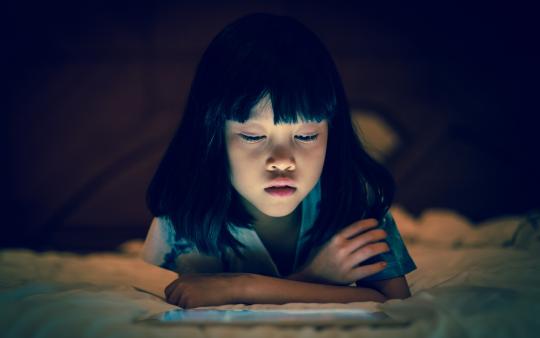As technology, social media, and all things “screen-time” become more and more a part of our day-to-day, it becomes harder to strike a healthy balance between being technologically competent and overly connected. From “zoning out” on TVs, tablets, smartphones, or video games, to compulsively checking Snapchat, Instagram, and Facebook, our fascination with the almighty and ubiquitous screen is not only impacting our children in ways that change them physically, socially, and emotionally, but parents’ own device use is also contributing to a changing family dynamic in many ways.
Neglecting play using all five senses
While we may feel that using educational tools on tablets can be helpful developmentally, the trouble lies with the amount of time this screen-based play takes away from other activities integral to healthy, complex, and well-rounded development. The more time spent on tablets and phones, the less time there is to engage in three-dimensional play, play that involves all five of our senses, and play that allows us to move our bodies. This means ensuring Paw Patrol and Candy Crush don’t completely replace finger painting, sandboxes, and soccer games.
Reducing parent-child interaction
Another downside is that screen time has the capacity to reduce parent-child interaction. While an e-book with sounds and animation may seem temptingly educational, it has been shown that these may distract from story comprehension and event sequencing in preschool-aged children. When we read a paper book to our children, there is also more opportunity for engaged question/answer time and for parent-led teaching like enhancing reading with your own animal sounds and funny voices that not only educate but perpetuate the child’s desire for your participation.
Promoting sedentary behaviour
Typically screen time promotes more sedentary behaviours, so it’s not shocking that there is a correlation between screen time and obesity. There have been observational studies showing that when community-based efforts, such as within a school population, are made in reducing use of screens, weight gain in children has been reduced. This association between screens (particularly television) and weight gain is thought to be correlated to a combination of less physical activity, increased calorie intake while viewing, and negative impacts on sleep quality.
Screen time impairs sleep
All parents know a sleep-deprived child is not a happy camper, not to mention a sleep-deprived mom or dad. Sleep is an integral part of proper childhood development and of the overall health of our entire families. There has been more and more attention given to how screen-time is impacting our ability to sleep well. A 2015 literature review found that the use of screens before bed negatively impacted sleep, primarily showing shortened duration and delayed timing, though not establishing causality. We do know, however, that screens emit blue light that impacts the natural rhythms of our sleep-wake cycle by suppressing melatonin and further contributing to poor sleep quality. In a 2006 poll of American adolescents, 97% were shown to have at least one electronic device available for use in their bedrooms. Avoiding the use of any form of screens for an hour or more before bed can support more restful sleep.
Difficulty with social connection
Not only is this increased amount of technology-based living impacting our physical development, but we are now starting to see it is potentially changing our mental health and well-being too. Even when our phones are on silent, our connected smart watches vibrate to let us know we got an IG “like”, an email, or a text. Try as we may to ignore it, all those notifications sit anxiously at the edge of our consciousness making it difficult to focus on any conversation in progress, and even when we know better, we may find ourselves scrolling at the dinner table. We know that eye contact is an incredibly important part of social engagement, allowing us to both read and react appropriately to the other person’s words, attitudes, and feelings so it stands to reason that our eyes-on-screens lifestyle would correlate with changes in social behaviour. This is an active area of research and one study has shown that increased parental use of screens is strongly associated with increased acting out and other attention-getting behaviours.
Overstimulation leads to challenging behaviour
One study published by the American Academy of Pediatrics suggests that limiting screen time and ensuring quality sleep can help reduce impulsivity in children. Psychiatrist Victoria L. Dunckley argues that too much screen time, especially interactive screen time (gaming, social media, etc.) creates an overstimulation in our brains which can contribute to a host of behavioural challenges including anxiety, poor self-regulation, irritability, tantrums, poor memory, poor eye contact, and insomnia.
Now for some good news…
Technology and screen time do happen to confer a variety of benefits to learning and development, so an outright ban is not necessary! This is particularly true in children over the age of 5, as they are more able to comprehend and use digital media to enhance their learning experiences. The Canadian Paediatric Society estimates that Ontario teenagers spend about 7.5 hours/day on a variety of screens, but that they are less negatively impacted than younger children. In fact, there’s evidence that the moderate use of screens, especially game-based play, can positively impact cognitive skills, social relationships, visual-spatial memory, problem solving skills, and sense of well-being. It’s important to remember that the key to such benefits is mindful use.
Less screen, more time
It is entirely possible to establish boundaries and reach compromises where parents cultivate an environment that finds children (and themselves) well-adapted to a technology-focused society while still providing irresistible opportunities for activities and habits that nurture health and relationship.
Participate in collaborative screen time
If you are using screen time as an educational tool, choose the content intentionally and spend time helping your child navigate it. As with any game or play in which you would traditionally engage with your child, make it a collaborative activity and actively participate by asking and encouraging questions. This also applies to viewing of videos, movies, and TV shows. This can help not only to ensure its age-appropriate and aligned with family values and goals but also allows you to help your children to recognize, understand, and question media messages and problematic content. Make use of parental controls and privacy settings for social media accounts to ensure safe use.
Consider a curfew
Set a screen “closing-time” and try to include the whole family (yes, you too mom and dad!). Remember the blue-light in digital media can have a negative impact on sleep by suppressing melatonin so set a curfew that gives the whole family one to two hours of screen-free time before bed. If screen use close to bedtime is unavoidable, use blue-light blocking glasses to minimize the impact on melatonin. Many smartphones also allow you to set a time at which the screen light will automatically shift to warmer tones to reduce the blue light exposure.
Limit duration of screen use
This can still give some autonomy to your kids so they can choose what platform (movies, gaming, social media) they want to devote those minutes/hours towards and can divide that time as they wish. Younger kids can be given a checklist of activities to complete before screen time is permitted. Unplugged activities like playing outside, reading a book, completing a chore, finishing homework, making a craft, 30 minutes of actively playing or exercise could all be features on the checklist. Once a pre-agreed upon number of activities have been completed, then they can enjoy one hour of screen time!
The World Health organization recently updated their guidelines on the use of screen time in children under 5 years old. The recommendations now state that children under 2 years old should have zero screen time while those under 5 should be limited to 1 hour per day!
Establish screen-free zones
Because screens can diminish the quality of social interactions, limiting screen time during certain events, outings, or mealtimes may be a helpful way to keep everyone engaged. Additionally, the use of screens during homework should be limited to relevant sites or resources to avoid media multitasking which may interfere with attention and quality of work. If necessary, setting parental controls, automatically disabling the internet during certain hours, and blocking sites altogether may help curb the appeal.
Be the user you want them to see
Remember that a large part of our children’s development is modeled on our own behaviours. This is particularly important for children under five years old because healthy habits are more easily established earlier in life. Moderate your own use of screens by choosing books or magazines for information or entertainment, plan active and collaborative social activities for family time, and apply the above recommendations to your own habits!
When it comes to screen time, mindful moderation is key. When we know some of the pitfalls and signs of overuse, we can stay better motivated to set up solid boundaries. Finding solutions and applying them in ways that work best for your family is the most important factor and happily the above techniques lend themselves well to customization, making managing screen time a lot easier to navigate!
Want to read more on this? Head over to The Impact of Non-Chemical Toxins on Children for an in-depth discussion on how our modern world may be hurting our kids.






